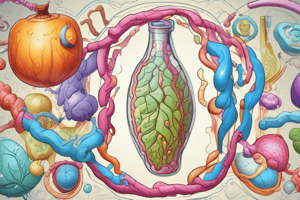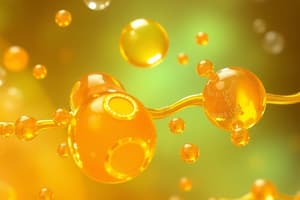Podcast
Questions and Answers
What is the primary form in which fats are stored in the body?
What is the primary form in which fats are stored in the body?
- Glycogen
- Cholesterol
- Phospholipids
- Triacylglycerols (correct)
Which macromolecule yields the highest amount of energy per gram when metabolized?
Which macromolecule yields the highest amount of energy per gram when metabolized?
- Proteins
- Nucleic Acids
- Carbohydrates
- Fats (correct)
What process is necessary for the digestion and absorption of triacylglycerols in the intestines?
What process is necessary for the digestion and absorption of triacylglycerols in the intestines?
- Fermentation
- Emulsification (correct)
- Transamination
- Hydrolysis
Acetyl CoA is converted to which compound before it can be transported to the cytosol?
Acetyl CoA is converted to which compound before it can be transported to the cytosol?
Which organ is primarily responsible for the synthesis of fatty acids from carbohydrates?
Which organ is primarily responsible for the synthesis of fatty acids from carbohydrates?
Which fatty acid is synthesized first and then used as a precursor for other fatty acids?
Which fatty acid is synthesized first and then used as a precursor for other fatty acids?
Which property of triacylglycerols allows them to be stored extracellularly?
Which property of triacylglycerols allows them to be stored extracellularly?
What role does albumin play in lipid metabolism?
What role does albumin play in lipid metabolism?
What is the primary location where β-oxidation of fatty acids occurs?
What is the primary location where β-oxidation of fatty acids occurs?
Which key step follows the sequential oxidation of fatty acids to acetyl CoA in β-oxidation?
Which key step follows the sequential oxidation of fatty acids to acetyl CoA in β-oxidation?
Which type of fatty acids can humans not desaturate beyond carbon 9?
Which type of fatty acids can humans not desaturate beyond carbon 9?
What role does carnitine play in the process of β-oxidation?
What role does carnitine play in the process of β-oxidation?
Which statement regarding the use of fatty acids as fuel in erythrocytes is accurate?
Which statement regarding the use of fatty acids as fuel in erythrocytes is accurate?
What is generated from the complete combustion of fatty acids during β-oxidation?
What is generated from the complete combustion of fatty acids during β-oxidation?
What can acetyl CoA be converted to if glucose becomes unavailable?
What can acetyl CoA be converted to if glucose becomes unavailable?
Which fatty acid is specifically converted to palmitoyl-CoA during the activation process?
Which fatty acid is specifically converted to palmitoyl-CoA during the activation process?
What condition can lead to reduced synthesis of carnitine in the body?
What condition can lead to reduced synthesis of carnitine in the body?
During ketogenesis, which substance is primarily produced and released into the blood?
During ketogenesis, which substance is primarily produced and released into the blood?
Which statement best describes the role of ketone bodies during prolonged fasting?
Which statement best describes the role of ketone bodies during prolonged fasting?
Which condition is characterized by elevated levels of ketone bodies in the blood and urine?
Which condition is characterized by elevated levels of ketone bodies in the blood and urine?
What is likely to occur if ketoacidosis is left uncontrolled?
What is likely to occur if ketoacidosis is left uncontrolled?
What treatment is typically first administered to a patient suffering from diabetic ketoacidosis?
What treatment is typically first administered to a patient suffering from diabetic ketoacidosis?
Which of the following is true about the breath of individuals in ketosis?
Which of the following is true about the breath of individuals in ketosis?
What is a potential consequence of excessive alcohol consumption regarding ketone body production?
What is a potential consequence of excessive alcohol consumption regarding ketone body production?
What is the primary role of carnitine in the metabolism of fatty acids?
What is the primary role of carnitine in the metabolism of fatty acids?
How does the β-oxidation process affect the carbon length of fatty acids?
How does the β-oxidation process affect the carbon length of fatty acids?
What products are generated during the β-oxidation of long-chain fatty acids?
What products are generated during the β-oxidation of long-chain fatty acids?
What is the total net energy yield from the complete β-oxidation of palmitic acid?
What is the total net energy yield from the complete β-oxidation of palmitic acid?
Which amino acids are precursors for the synthesis of carnitine?
Which amino acids are precursors for the synthesis of carnitine?
What initiates the conversion of fatty acids to fatty acyl-CoA?
What initiates the conversion of fatty acids to fatty acyl-CoA?
Where in the mitochondria does the transfer of the fatty acyl group from carnitine to coenzyme A occur?
Where in the mitochondria does the transfer of the fatty acyl group from carnitine to coenzyme A occur?
What happens to carnitine after it has helped transport fatty acyl groups into the mitochondria?
What happens to carnitine after it has helped transport fatty acyl groups into the mitochondria?
Flashcards
Energy Density of Fats
Energy Density of Fats
Fats are the most efficient energy storage molecules, yielding 9.3 kcal/g compared to carbohydrates and proteins (4.1 kcal/g). This high energy density is due to their long hydrocarbon chains.
Excess Energy Storage as Fat
Excess Energy Storage as Fat
When our calorie intake exceeds our energy expenditure, the surplus energy is stored as fat in our bodies.
Fat Storage Location
Fat Storage Location
Fats, primarily in the form of triacylglycerols, are stored in specialized cells called adipocytes, collectively known as adipose tissue.
Metabolic Activity of Fats
Metabolic Activity of Fats
Signup and view all the flashcards
Fat Synthesis from Glucose and Protein
Fat Synthesis from Glucose and Protein
Signup and view all the flashcards
De Novo Fatty Acid Synthesis
De Novo Fatty Acid Synthesis
Signup and view all the flashcards
Acetyl-CoA Transport and Conversion
Acetyl-CoA Transport and Conversion
Signup and view all the flashcards
Palmitate as Fatty Acid Precursor
Palmitate as Fatty Acid Precursor
Signup and view all the flashcards
β-Oxidation
β-Oxidation
Signup and view all the flashcards
Carnitine
Carnitine
Signup and view all the flashcards
Fatty Acid Activation
Fatty Acid Activation
Signup and view all the flashcards
Ketone Bodies
Ketone Bodies
Signup and view all the flashcards
Essential Fatty Acids
Essential Fatty Acids
Signup and view all the flashcards
Cellular Respiration
Cellular Respiration
Signup and view all the flashcards
Desaturase Limitations
Desaturase Limitations
Signup and view all the flashcards
Fatty Acids Derived from Palmitic Acid
Fatty Acids Derived from Palmitic Acid
Signup and view all the flashcards
β-Oxidation of Fatty Acids
β-Oxidation of Fatty Acids
Signup and view all the flashcards
Fatty Acyl-CoA to Fatty Acyl-Carnitine
Fatty Acyl-CoA to Fatty Acyl-Carnitine
Signup and view all the flashcards
Carnitine Acyl Transferase I (CAT I)
Carnitine Acyl Transferase I (CAT I)
Signup and view all the flashcards
Acyl-Carnitine Transporter
Acyl-Carnitine Transporter
Signup and view all the flashcards
Fatty Acyl-Carnitine to Fatty Acyl-CoA
Fatty Acyl-Carnitine to Fatty Acyl-CoA
Signup and view all the flashcards
Carnitine Acyl Transferase II (CAT II)
Carnitine Acyl Transferase II (CAT II)
Signup and view all the flashcards
Products of β-Oxidation
Products of β-Oxidation
Signup and view all the flashcards
What is the role of carnitine?
What is the role of carnitine?
Signup and view all the flashcards
What are the conditions that can cause carnitine deficiency?
What are the conditions that can cause carnitine deficiency?
Signup and view all the flashcards
What is Ketogenesis?
What is Ketogenesis?
Signup and view all the flashcards
Where are ketone bodies produced?
Where are ketone bodies produced?
Signup and view all the flashcards
How are ketone bodies used?
How are ketone bodies used?
Signup and view all the flashcards
What are the signs of excess ketone body production?
What are the signs of excess ketone body production?
Signup and view all the flashcards
What is ketosis?
What is ketosis?
Signup and view all the flashcards
What is diabetic ketoacidosis?
What is diabetic ketoacidosis?
Signup and view all the flashcards
Study Notes
Lipid Metabolism
- Fats (triglycerides) are high-energy molecules, yielding 9.3 kcal of energy. Carbohydrates and proteins yield 4.1 kcal.
- Fats are the best heat producers compared to carbohydrates and proteins due to the long hydrocarbon chains in fats.
- Excess energy consumed is stored as fats.
- Fats are hydrophobic and inert, allowing storage for long periods.
- Fats are stored as triacylglycerols in fat cells (adipose tissue).
- Fats can be stored in large amounts, whereas carbohydrates are stored as glycogen with limited storage capacity.
- Proteins cannot be stored.
Lipid Metabolism: Digestion & Absorption
- Dietary lipids (CE, PL, TAG) initially remain unchanged in the mouth.
- In the stomach, some short- and medium-chain fatty acids are digested.
- Most CE, PL, and TAG digestion occurs in the small intestine.
- Bile salts emulsify lipids, aiding in their breakdown by pancreatic enzymes.
- Pancreatic lipase degrades dietary lipids into free fatty acids and 2-monoglycerols.
- Chylomicrons (lymph) transport reesterified products to the bloodstream.
- Products include free fatty acids, 2-monoacylglycerol, remaining fragments of TAGs.
- The emulsified forms of digestive products (fatty acids and glycerol) are water-soluble and absorbed in the intestines.
Lipid Metabolism: Transport
- Free fatty acids and glycerols enter the cell membranes of adipocytes. These then pass into the bloodstream.
- Albumin helps transport fatty acids and glycerols.
Lipid Metabolism: Triglyceride Synthesis (Glycerol Phosphate Production)
- Liver cells use glucose to produce glycerol phosphate.
- This glycerol phosphate is a precursor for triacylglycerol production.
- Adipose tissue cells use the same glycolysis pathway to produce glycerol phosphate, also for triacylglycerol creation.
Lipid Metabolism: Fatty Acid Synthesis
- A large proportion of fatty acids are obtained from the diet.
- Carbohydrates and proteins from the diet can also be converted into fatty acids.
- Fatty acid synthesis occurs in the liver and lactating mammary glands.
- Acetyl CoA acts as a precursor in palmitate synthesis.
- Palmitate is used to create other long-chain fatty acids through processes in the endoplasmic reticulum and mitochondria.
- Enzymes in the endoplasmic reticulum (ER) are responsible for adding cis double bonds to fatty acids.
- Humans have desaturases for carbon 4, 5, 6, and 9, but do not have desaturases for carbons 10 and beyond, thus are unable to produce some long-chain fatty acids.
Lipid Metabolism: Fatty Acid Breakdown (β-Oxidation)
- Fatty acids are used for energy by undergoing β-oxidation in the mitochondrial matrix.
- Erythrocytes and the brain cannot use fatty acids as fuel due to the lack of mitochondria and the impermeable blood-brain barrier, respectively.
- β-oxidation is a catabolic process, completely breaking down fatty acids into CO2 and H2O, producing ATP.
- The process involves sequential oxidation of carbons in the fatty acid, producing acetyl CoA.
- Acetyl CoA enters the TCA cycle for further oxidation.
- β-oxidation produces molecules for further oxidative phosphorylation to create ATP.
- Other products of β-oxidation are NADH and FADH2 which enter the electron transport chain to generate ATP.
Lipid Metabolism: Carnitine
- Carnitine is acquired from the diet (meat products) or synthesized in the liver and kidneys.
- Heart and skeletal muscle depend on carnitine for fatty acid transport and metabolism.
- 97% of body carnitine is found in skeletal muscle.
- Deficiencies in carnitine can prevent the usage of long-chain fatty acids for fuel. Liver disease, malnutrition, strict vegetarianism, or hemodialysis can lead to such deficiencies.
Lipid Metabolism: Ketogenesis
- Ketogenesis occurs in the liver and kidney mitochondria.
- When energy sources are limited like during starvation, the liver produces ketone bodies such as acetoacetate, D-β-hydroxybutyrate (3-hydroxybutyrate), and acetone.
- These ketone bodies diffuse into the bloodstream to reach peripheral tissues, where they are converted back into acetyl-CoA via ketolysis, and enter the TCA cycle.
- Ketone bodies provide alternative energy sources, especially for the brain, when glucose is scarce.
- Under normal conditions, blood ketone levels are low (0.5 mg/100 mL). During starvation or diabetes, levels can rise, producing ketonemia and ketonuria (presence of ketone bodies in urine.)
- Acetone breath can also be a possible output.
- The brain can use ketone bodies for energy during prolonged fasting (starvation.)
Lipid Metabolism: Diabetic Ketoacidosis
- Diabetic ketoacidosis (DKA) is a serious complication of diabetes.
- Insulin deficiency leads to elevated blood glucose levels, and thus increased gluconeogenesis in the liver.
- This promotes lipolysis, increasing fatty acid release and subsequent hepatic ketogenesis.
- Ketone bodies accumulate in the blood (ketonemia), leading to metabolic acidosis (ketoacidosis). This can lead to coma or death if untreated.
- Treatment includes insulin to restore normal glucose metabolism, reducing ketone production. Additional measures like sodium bicarbonate may be required for dehydration correction.
- Alcohol use can also elevate ketone body production.
Studying That Suits You
Use AI to generate personalized quizzes and flashcards to suit your learning preferences.




